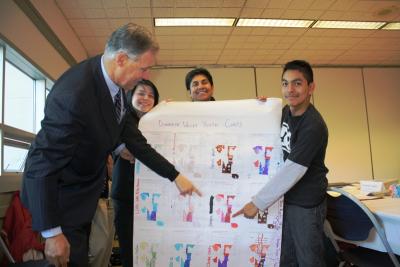This post originally appeared on the OneAmerica Blog
his is the final post in our three-part series on the Frontlines of Climate Change, written by OneAmerica Policy Associate Ellicott Dandy. To learn about how climate change drives migration, click here. For a look at how immigrant communities in the United States are affected by climate disruption, click here.
Part III: Taking the Right Action on Climate
For those of us who have struggled to think about climate change in a way that makes the problem tangible, perhaps the lens of migration is what we’ve been searching for. This is the perspective that connects the global environmental threat of climate change to the local experience. This is the face of the climate change frontline, and it’s the experience that must inform climate solutions. The strongest possible action on climate change is one that improves the environment for all Washingtonians, and protects and empowers the communities at the climate frontlines.
Washington is not the first place to put a price on carbon. Luckily for us, there are many other experiences to learn from as we get closer to our own carbon tax or cap-and-trade system. An important lesson from multiple jurisdictions is that a policy that only attempts to decrease levels of atmospheric carbon will not automatically improve conditions for frontline communities. In fact, carbon prices that are not carefully designed with these communities in mind can do more social harm than good. They might increase the cost of living or allow big polluters to buy their way out of compliance. We at OneAmerica believe that a carbon price that prioritizes the needs of hardest-hit communities—including immigrants and refugees—can bring vital improvements to their environments and will be the strongest, most holistic action on climate that the world has ever seen.
But it requires an analysis grounded as much in racial and economic equity as in atmospheric science. Policymakers must look at the outcomes we all need and embrace this urgency to act on climate as an opportunity to clean up communities, hold polluters responsible, and usher all Washingtonians into the low-carbon economy. Today will be the day that process begins in earnest. This afternoon, Governor Inslee made the final stops on his climate tour in the South Park neighborhood and at our partner organization, El Centro de la Raza. In South Park, he learned about the area’s burden of transportation-related pollution and the high rates of asthma that come from it. At El Centro de la Raza, the discussionwas about creating green jobs for people of color and people with lower incomes to build healthy communities with multimodal transportation options and green infrastructure. This is an incredible opportunity for the Governor to imagine his carbon price from the ground up; he’ll be able to see communities’ needs and envision climate solutions that meet them and in so doing, strengthen the goals of his executive order.
Through his position on the Governor’s Carbon Emissions Reduction Taskforce, OneAmerica Executive Director, Rich Stolz, has had the opportunity to engage with other stakeholders across the state, the Governor’s policy staff, and allied organizations both new and familiar. Together, we have worked to achieve our common goals of cutting greenhouse gas emissions and creating healthier environments for our communities through a carbon price that meets the needs of people at the frontlines first. We commend the Governor for making health and equity a focus of his climate tour, and we look forward to reading his policy proposal in the coming weeks.



